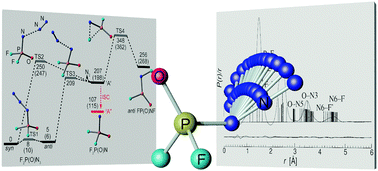Raphael J. F. Berger*d
a College of Chemistry, Chemical Engineering and Materials Science, Soochow University, 215123 Suzhou, China
b Lehrstuhl für Anorganische Chemie und Strukturchemie, Centre for Molecular Materials CM2, Universitätsstraße 15, D-33615 Bielefeld, Germany
c Institut für Chemie und Biochemie, Freie Universität Berlin, 14195 Berlin, Germany
d Materialchemie, Paris-Lodron-Universität Salzburg, Hellbrunner Str. 34, A-5020 Salzburg, Austria
Phys. Chem. Chem. Phys. 2015, 17, 8784-8791
The conformational composition, molecular structure and decomposition of difluorophosphoryl azide F2P(O)N3 in the gas phase were studied using gas electron diffraction (GED), matrix isolation IR spectroscopy, and quantum-chemical calculations, respectively. While computational methods predict only minor differences in the total energy between the two possible conformers (syn and anti), the analysis of electron diffraction data reveals the dominating abundance of the syn conformer in the gas phase at room temperature. Ab initio frequency analyses suggest that a low-frequency large-amplitude motion of the N3 group with respect to the P–N–N–N torsion is to be expected for the syn conformer. The large amplitude motion was included explicitly into the GED structure refinement procedure. It presumably contributes to a thermodynamic stabilization of the syn-conformer with respect to the anti-conformer in the gas phase at ambient temperature. Upon flash vacuum pyrolysis, this syn conformer undergoes a stepwise decomposition via the difluorophosphoryl nitrene, F2P(O)N, which features as the first experimentally observed phosphoryl nitrene that can be thermally produced in the gas phase. To reveal the reaction mechanism, quantum-chemical calculations on the potential energy surface (PES) of F2P(O)N3 were performed. Both B3LYP/6-311+G(3df) and CBS-QB3 calculation results strongly support a stepwise decomposition into the singlet F2P(O)N, which prefers intersystem crossing to the thermally persistent triplet ground state instead of a Curtius rearrangement into FP(O)NF.

链接:
//pubs.rsc.org/en/content/articlelanding/2015/cp/c5cp00850f#!divAbstract